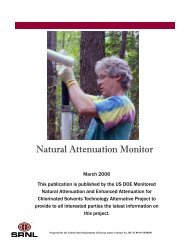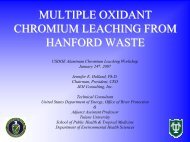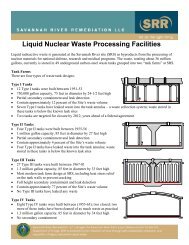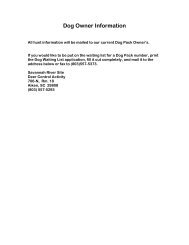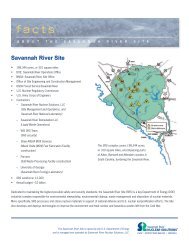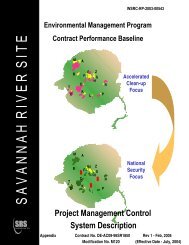Tanks 5 and 6 Oxalic Acid Dissolution and Tank 5 and 6 ...
Tanks 5 and 6 Oxalic Acid Dissolution and Tank 5 and 6 ...
Tanks 5 and 6 Oxalic Acid Dissolution and Tank 5 and 6 ...
Create successful ePaper yourself
Turn your PDF publications into a flip-book with our unique Google optimized e-Paper software.
SRNL-MS-2010-00246<br />
<strong><strong>Tank</strong>s</strong> 5 <strong>and</strong> 6 <strong>Oxalic</strong> <strong>Acid</strong> <strong>Dissolution</strong> <strong>and</strong><br />
<strong>Tank</strong> 5 <strong>and</strong> 6 Characterization<br />
M. R. Poirier, R. Jolly, <strong>and</strong> G. D. Thaxton<br />
November 18, 2010
Outline of Talk<br />
Introduction<br />
Description of Testing<br />
Simulant Testing<br />
Actual Waste Testing<br />
Test Results<br />
Description of <strong>Oxalic</strong> <strong>Acid</strong> Cleaning in <strong>Tank</strong> Farm<br />
Results from <strong>Oxalic</strong> <strong>Acid</strong> Cleaning in <strong>Tank</strong> Farm<br />
Mechanical Cleaning<br />
Conclusions<br />
2
Introduction<br />
SRS will remove sludge as part of waste tank closure<br />
operations<br />
Bulk sludge removed by mixing it with available supernate <strong>and</strong><br />
transporting slurry to tank for processing (i.e., “mechanical cleaning”)<br />
Repeated multiple cycles with supernate being “recycled”<br />
Residual heel typically remains in tank<br />
Use oxalic acid solutions to disperse or dissolve sludge heel<br />
Conducted demonstrations to develop <strong>and</strong> evaluate process<br />
Simulant<br />
Actual waste<br />
Performed chemical cleaning in two SRS waste tanks<br />
Two oxalic acid strikes<br />
Spray wash<br />
Water wash<br />
Collected liquid <strong>and</strong> solid samples to evaluate effectiveness<br />
3
Testing – Simulant Demonstration<br />
<strong>Oxalic</strong><br />
<strong>Acid</strong><br />
Vessel 2<br />
Neutralization<br />
<strong>Tank</strong><br />
Transfer<br />
Pump<br />
Vessel 1<br />
<strong>Dissolution</strong><br />
<strong>Tank</strong><br />
Simulated sludge <strong>and</strong> salt<br />
solution were placed into<br />
dissolution vessel<br />
Carbon steel coupons were<br />
placed in dissolution vessel<br />
for corrosion testing<br />
Transferred 8 wt % oxalic<br />
acid to dissolution vessel<br />
over 7 days<br />
Vessel not mixed until<br />
agitator blade covered<br />
After acid addition,<br />
dissolution continued for<br />
50 hours<br />
Tests conducted at 25, 50,<br />
<strong>and</strong> 75 °C with <strong>and</strong> without<br />
mixing<br />
4
Testing – Actual Waste Test<br />
Occurred via remote h<strong>and</strong>ling in the SRNL’s<br />
Shielded Cells<br />
Carbon steel coupon was placed in contact<br />
with the solution for the duration of each<br />
test<br />
Reactor heated using a heating mantle for<br />
heating to 50 <strong>and</strong> 75 °C<br />
Solution temperature monitored during test<br />
Reactors mixed with stir bar rather than<br />
impeller; mixing less vigorous than simulant<br />
tests<br />
<strong>Oxalic</strong> acid added as batch<br />
5
Test Conditions<br />
Test<br />
Sludge/Surface<br />
Area (gal/ft 2 )<br />
<strong>Oxalic</strong><br />
<strong>Acid</strong>/Surface<br />
Area (gal/ft 2 )<br />
<strong>Oxalic</strong><br />
<strong>Acid</strong>/Sludge +<br />
Supernate<br />
Volume<br />
Actual Waste<br />
0.1<br />
4.2<br />
20.7<br />
Simulant<br />
0.25<br />
8.8<br />
10.1<br />
<strong>Tank</strong> 5 (nominal)<br />
0.56<br />
11.8<br />
8.8<br />
<strong>Tank</strong> 5 (actual)<br />
0.3<br />
9.6<br />
32<br />
<strong>Tank</strong> 6 (actual)<br />
0.2<br />
9.6<br />
32<br />
Attempted to match sludge to surface area, oxalic acid to surface area,<br />
<strong>and</strong> oxalic acid to sludge + supernate volume ratios<br />
6
Results – Simulant Test Visual Results<br />
Formation of white colored<br />
solids under acid addition<br />
point<br />
More acid led to formation<br />
of bright yellow solids<br />
Solids spread throughout<br />
vessel<br />
White layer across residual<br />
sludge solids<br />
Brown/rust solids<br />
Emerald green solution<br />
color (iron oxalate)<br />
7
Results – Actual Waste Test Visual Results<br />
• At end of oxalic acid addition to the sludge, layer of<br />
whites solids with slight blue color remained at<br />
bottom<br />
Raman spectra indicate the presence of sodium oxalate, iron<br />
oxalate <strong>and</strong> iron hydroxide<br />
XRD indicates the presence of calcium oxalate<br />
• Sodium oxalate due to large concentration of<br />
sodium that exceeds solubility in oxalic acid<br />
8
Sludge <strong>Dissolution</strong> during Demonstrations<br />
Test<br />
Uranium<br />
Iron<br />
Manganese<br />
Nickel<br />
Simulant 25 °C w/mixing<br />
100 %<br />
99 %<br />
32 %<br />
0.2 %<br />
Simulant 50 °C w/mixing<br />
100 %<br />
99 %<br />
43 %<br />
0.6 %<br />
Simulant 75 °C w/mixing<br />
99 %<br />
94 %<br />
24 %<br />
0.06 %<br />
Simulant 25 °C w/o mixing<br />
99 %<br />
100 %<br />
57 %<br />
2.0%<br />
Simulant 50 °C w/o /mixing<br />
99 %<br />
96 %<br />
33 %<br />
0.5 %<br />
Simulant 75 °C w/o mixing<br />
99 %<br />
98 %<br />
37 %<br />
0.2 %<br />
Actual Waste 50 °C w/mixing<br />
73 %<br />
62 %<br />
40 %<br />
0.1 %<br />
Actual Waste 75 °C w/mixing<br />
87 %<br />
76 %<br />
59 %<br />
0.1 %<br />
• Good removal of uranium <strong>and</strong> iron – removal better in simulant tests<br />
• Poor removal of nickel – good agreement between simulant <strong>and</strong> actual waste<br />
• Good agreement between simulant <strong>and</strong> actual waste for manganese removal<br />
9
Chemical Cleaning in SRS Waste <strong><strong>Tank</strong>s</strong><br />
<strong>Oxalic</strong> <strong>Acid</strong><br />
Sample<br />
Residual <strong>Tank</strong><br />
Waste<br />
Mixed in Waste <strong>Tank</strong><br />
For several days<br />
Transferred to<br />
Downstream tank<br />
<strong>Acid</strong> Strike 1 – Addition of 8% OA to waste tank with soaking <strong>and</strong> mixing<br />
<strong>Acid</strong> Strike 2 – Addition of 8% OA to waste tank with soaking<br />
Spray Wash – Addition of 8% OA through 2 spray masts, followed by water<br />
addition <strong>and</strong> soaking.<br />
Water Wash – Addition of well water to waste tank with mixing.<br />
10
Liquid Samples from <strong>Tank</strong> 5<br />
• Sample pH measured 4 following Strike 1 rather than 1 – 2<br />
Residual sludge heels, interstitial liquid, films on tank walls <strong>and</strong><br />
residual base will titrate oxalic acid to reduce effective H 3<br />
O +<br />
concentration.<br />
• pH measured 2 following Strike 2<br />
• Liquid samples showed good dissolution of U, Fe, Al, Na, Mn,<br />
137<br />
Cs, <strong>and</strong> 90 Sr<br />
Except for Fe, solution concentrations decreased significantly<br />
following subsequent strikes<br />
• Measured oxalate about half of expected<br />
Likely formed metal precipitates<br />
11
Liquid Samples from <strong>Tank</strong> 6<br />
• pH of sample measured 2 following Strikes 1 <strong>and</strong> 2<br />
as expected<br />
• Liquid samples showed good dissolution of U, Fe,<br />
Al, Na, Mn, 137 Cs, <strong>and</strong> 90 Sr<br />
Concentrations decreased significantly following subsequent<br />
strikes<br />
• Measured oxalate about half of expected<br />
Likely formed metal precipitates<br />
12
Solid Samples from Waste <strong><strong>Tank</strong>s</strong><br />
• 70 wt % solids<br />
• Major cation constituents were Fe, Ni, <strong>and</strong> Mn<br />
• Concentrations of 90 Sr, 241 Am, 244 Cm, <strong>and</strong> 137 Cs higher than<br />
other radionuclides<br />
• XRD analysis of <strong>Tank</strong> 6 residual solids showed primary<br />
species, in order, are<br />
1. Hematite<br />
2. Maghemite<br />
3. Nickel Oxalate Hydrate<br />
4. Goethite<br />
• Performed mass balance to calculate the fraction removed<br />
during chemical cleaning<br />
X<br />
C<br />
liqremoved<br />
V<br />
liqremoved<br />
<br />
C<br />
V<br />
C<br />
V<br />
<br />
C<br />
V<br />
<br />
<br />
<br />
liqremoved<br />
liqremoved<br />
solid<br />
solid<br />
liqremaining<br />
liqremaining<br />
13
Fraction Removed <strong>and</strong> Sludge Remaining in <strong>Tank</strong> 5<br />
Species Removed Remaining Species Removed<br />
Al 90% 33 kg<br />
90 Sr 83%<br />
Fe 32% 4,830 kg<br />
99 Tc 37%<br />
Mn 48% 875 kg<br />
137 Cs 97%<br />
Na 98% 43 kg<br />
239/240 Pu 6%<br />
Ni 1% 2,138 kg<br />
238 Pu 5%<br />
U 99% 46 kg<br />
241 Am 1%<br />
Hg n.m. 37 kg<br />
242m Am 1%<br />
n.m. not measured<br />
242 Cm 1%<br />
Cm 3%<br />
• Good removal of U, Na, <strong>and</strong> Al<br />
• Poor removal of Ni<br />
• Most of remaining sludge mass is<br />
Fe <strong>and</strong> Ni<br />
• Good removal of Cs <strong>and</strong> Sr<br />
• Poor removal of Tc, Pu, Am, <strong>and</strong> Cm<br />
• Most of remaining activity 90 Sr<br />
14
Fraction Removed <strong>and</strong> Sludge Remaining in <strong>Tank</strong> 6<br />
Species Removed Remaining Species Removed<br />
Al 90% 48 kg<br />
90 Sr 86%<br />
Fe 73% 1900 kg<br />
99 Tc 2.0%<br />
Mn 49% 267 kg<br />
137 Cs 86%<br />
Na 98% 31 kg<br />
239/240 Pu 14%<br />
Ni 2% 1219 kg<br />
238 Pu 14%<br />
U 98% 42 kg<br />
241 Am 6%<br />
Hg n.m. 93 kg<br />
243 Am 7%<br />
242m<br />
n.m. not measured<br />
Am 7%<br />
244 Cm 7%<br />
241 Pu 6%<br />
• Good removal of U, Na, <strong>and</strong> Al<br />
• Poor removal of Ni<br />
• Better Fe removal than <strong>Tank</strong> 5<br />
•Most of remaining sludge mass is<br />
Fe <strong>and</strong> Ni<br />
• Good removal of Cs <strong>and</strong> Sr<br />
• Poor removal of Tc, Pu, Am, <strong>and</strong> Cm<br />
• Better Pu, Am, <strong>and</strong> Cm removal than<br />
<strong>Tank</strong> 5<br />
• Most of remaining activity 90 Sr<br />
15
Comparing <strong>Oxalic</strong> <strong>Acid</strong> <strong>Dissolution</strong> in <strong>Tank</strong> Farm with Demonstrations<br />
Species <strong>Tank</strong> 5 <strong>Tank</strong> 6<br />
Actual Waste<br />
Demonstration<br />
Simulant<br />
Demonstration<br />
Fe 21% 69% 62% 99%<br />
U 89% 80% 73% 100%<br />
Mn 40% 46% 40% 43%<br />
Ni 0.6% 1.6% 0.1% 0.6%<br />
Na 88% 76% 96% 96%<br />
Al 81% 85% 84% n.m.<br />
238 Pu 3.5% 13% 2.9% n.m.<br />
239/240 Pu 4.4% 13% 3.2% n.m.<br />
n.m. not measured<br />
• <strong>Tank</strong> Farm removal efficiencies are for first strike<br />
• Except for Fe, good agreement between <strong>Tank</strong> 5 chemical cleaning <strong>and</strong> actual waste<br />
demonstration<br />
16
Comparing <strong>Oxalic</strong> <strong>Acid</strong> <strong>Dissolution</strong> in <strong>Tank</strong> Farm with Laboratory Demonstrations<br />
• Waste tank samples showed less iron removal than in<br />
simulant demonstration<br />
Iron in simulant demonstration added as ferric hydroxide (easily<br />
dissolved by oxalic acid)<br />
Iron in SRS waste tanks primarily magnetite <strong>and</strong> hematite<br />
Hematite more difficult to dissolve by oxalic acid<br />
• Testing <strong>and</strong> waste tank samples show poor nickel removal<br />
Nickel forms precipitate with oxalic acid (nickel oxalate)<br />
• Testing <strong>and</strong> waste tank samples show poor plutonium<br />
removal<br />
Plutonium forms precipitate with oxalate<br />
17
Phase 2 Mechanical Cleaning<br />
• SRR performed additional heel removal (Phase II Mechanical<br />
Cleaning) by a “Feed <strong>and</strong> Bleed” process in <strong>Tank</strong> 5<br />
• Process included addition of well water, tank mixing <strong>and</strong><br />
liquid removal.<br />
• Sludge heel started at estimated 3300 gallons waste. After<br />
Feed <strong>and</strong> Bleed Process, <strong>Tank</strong> 5 contained 4065 gallons of<br />
liquid.<br />
• Heel sample collected <strong>and</strong> sent to SRNL for characterization.<br />
• Final mapping of tank planned in future.<br />
18
Composition of Solids Remaining after Feed <strong>and</strong> Bleed<br />
Species<br />
Conc. (mg/kg)<br />
Species<br />
Conc. (Ci/g)<br />
Al<br />
4941<br />
90 Sr<br />
1.4 x 10 -2<br />
Fe<br />
469,000<br />
99 Tc<br />
1.7 x 10 -9<br />
Hg<br />
2060<br />
137 Cs<br />
3.0 x 10 -4<br />
Mn<br />
38,000<br />
238 Pu<br />
2.2 x 10 -6<br />
Ni<br />
64,000<br />
239/240 Pu<br />
9.5 x 10 -6<br />
U<br />
10,700<br />
241 Am<br />
7.3 x 10 -5<br />
242m Am<br />
1.7 x 10 -7<br />
242 Cm<br />
1.6 x 10 -7<br />
244 Cm<br />
4.2 x 10 -5<br />
19
Conclusions<br />
With exception of iron, dissolution of sludge components from<br />
<strong>Tank</strong> 5 agreed with results from actual waste demonstration<br />
Fraction of iron removed from <strong>Tank</strong> 5 by chemical cleaning was<br />
significantly less than fraction removed in demonstrations<br />
Likely cause of difference is higher pH in the initial oxalic acid strike <strong>and</strong><br />
different iron species in the waste<br />
Subsequent strikes removed additional iron<br />
Most of sludge mass remaining in tanks is Fe <strong>and</strong> Ni<br />
Remaining sludge contains significant amounts of Ba, Cr, & Hg<br />
Most of radioactivity remaining in tanks is derived from 90 Sr.<br />
Chemical cleaning efficient at removing U, Al, Ca, Na, Sr, & Cs<br />
Chemical cleaning not efficient at removing Ni, Hg, Pu, Am, & Cm<br />
Mechanical cleaning is now complete for <strong>Tank</strong> 5.<br />
20



